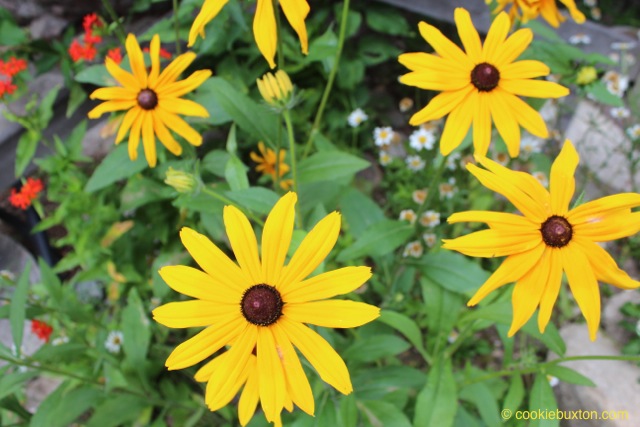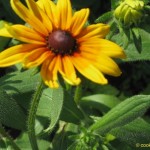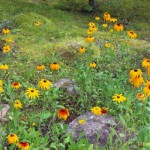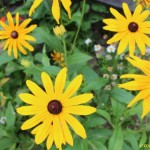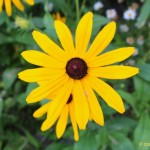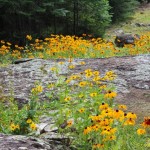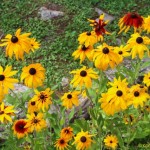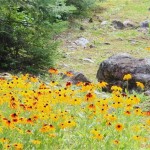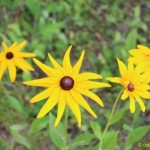Black-eyed Susan
If you live in North America, you have seen Black-eyed Susans dotting the countryside since you were old enough to ask how this attractive sunshine flower got its name.
Wildflower species of the Black-eyed Susan, such a familiar sight on the Canadian prairies, may be annual, biennial, or perennial plants, depending upon the species. Of the many types, Rudbeckia hirta and Rudbeckia fulgida species are prevalent. Commercially-sold hybrids are often intermingled with the wild species, escaping from cottage lots and country gardens. Several of my photographs in the gallery below were taken at Manitoba’s Booster Lake cottage country in Nopiming Provincial Park. The cottage garden, more on the wild side than cultivated, featured a beautiful mixture of the gorgeous bi-coloured R. hirta gloriosa (R. “Gloriosa”) along with other hybrids and possibly some wild species plants as well.
In my home garden, I have planted the perennial hybrid, R. fulgida var sullivantii (R. “Goldsturm”). Goldsturm is a German word meaning gold storm. This beautiful, robust plant was named the American Perennial Plant Association’s “Perennial Plant of the Year” in 1999, and for good reasons.
Black-eyed Susans can be planted in full sun and partly sunny locations. They produce abundant daisy-like deep yellow flowers atop their long stems, each flower featuring the distinctive dark brown centre of florets. The leaves are hairy, which you can see well in one of the photographs. These handsome plants bloom for many weeks, are drought tolerant, and seem immune to bugs and disease. They don’t seem to be much affected by poor soil. In short, they are wonderful plants to have in the home or cottage garden.
Black-eyed Susans can be quite tall, ranging from 45 to 60 cm (18 to 24 inches) for the Goldsturm variety. One species, R. lancinata, reaches heights of nine feet tall. Other species and varieties may be a little shorter, or taller, than the Goldsturm variety.
When purchasing, you will need a guide to Latin titles along with common names and varieties, as there are over 30 North American species, plus lots of well-known hybrids derived from various species plants. Black-eyed Susans can be annuals, biennials, and perennials and are at home in Zones 3 through 10.
You are perhaps still wondering about the name of this plant. How did the North American Black-eyed Susan get its name, you ask? Perhaps from the songs of British sailors from the early settler years. A poem written in the 1700s by a gentleman named John Gay (1685-1732) is described as being a popular source of lyrics for ballads. The poem describes the parting of a Black-eyed Susan and her sailor lover, Sweet William. It’s a rather sad tale, and such departures were a common theme in those days. This story is told from both Dear Susan and Sweet William’s points of view as they bid farefwell to one another before a long voyage. Below is the text of the poem as published in the anthology English Poetry I: From Chaucer to Gray. The Harvard Classics. 1909–14.
Black-eyed Susan, by John Gay
All in the Downs the fleet was moor’d,
The streamers waving in the wind,
When black-eyed Susan came aboard;
‘O! where shall I my true-love find?
Tell me, ye jovial sailors, tell me true
If my sweet William sails among the crew.’
William, who high upon the yard
Rock’d with the billow to and fro,
Soon as her well-known voice he heard
He sigh’d, and cast his eyes below:
The cord slides swiftly through his glowing hands,
And quick as lightning on the deck he stands.
So the sweet lark, high poised in air,
Shuts close his pinions to his breast
If chance his mate’s shrill call he hear,
And drops at once into her nest:—
The noblest captain in the British fleet
Might envy William’s lip those kisses sweet.
‘O Susan, Susan, lovely dear,
My vows shall ever true remain;
Let me kiss off that falling tear;
We only part to meet again.
Change as ye list, ye winds; my heart shall be
The faithful compass that still points to thee.
‘Believe not what the landmen say
Who tempt with doubts thy constant mind:
They’ll tell thee, sailors, when away,
In every port a mistress find:
Yes, yes, believe them when they tell thee so,
For Thou art present wheresoe’er I go.
‘If to fair India’s coast we sail,
Thy eyes are seen in diamonds bright,
Thy breath is Afric’s spicy gale,
Thy skin is ivory so white.
Thus every beauteous object that I view
Wakes in my soul some charm of lovely Sue.
‘Though battle call me from thy arms
Let not my pretty Susan mourn;
Though cannons roar, yet safe from harms
William shall to his Dear return.
Love turns aside the balls that round me fly,
Lest precious tears should drop from Susan’s eye:
The boatswain gave the dreadful word,
The sails their swelling bosom spread,
No longer must she stay aboard;
They kiss’d, she sigh’d, he hung his head.
Her lessening boat unwilling rows to land;
‘Adieu!’ she cries; and waved her lily hand.
Photos and Text: NK
Copyright: NK/cookiebuxton.com
Photo locations: My home garden; cottage country at Booster Lake, MB
Photo Gallery
Click on any photograph to enlarge, and click on the photograph to advance through the series.
